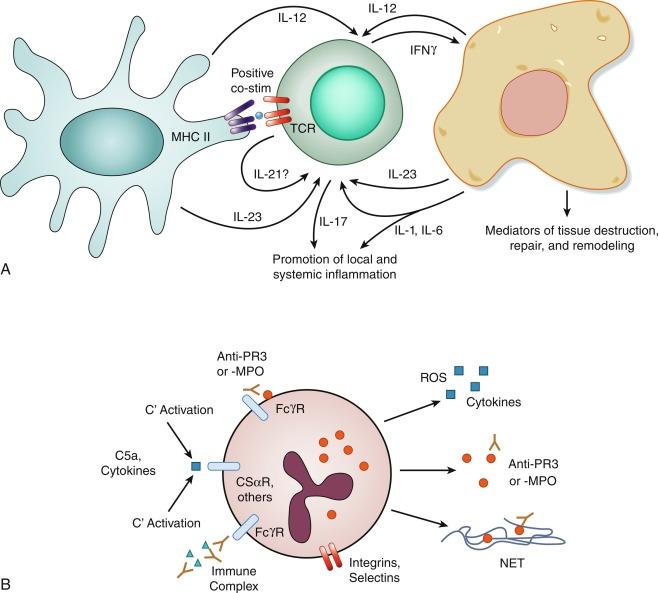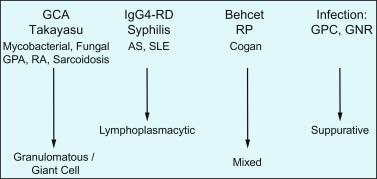Physical Address
304 North Cardinal St.
Dorchester Center, MA 02124
The term “vasculitis” encompasses diseases that share the feature of inflammatory destruction of blood vessels but otherwise include diverse clinical phenotypes and pathophysiologies. The rarity of the vasculitides and the paucity of animal models means that their pathophysiologies are not as well understood as in many other inflammatory diseases. However, a combination of genetic, epidemiologic, and laboratory-based studies has provided insight into ways that the vasculitides resemble or differ from each other, and, in a few cases, serology has provided breakthroughs into disease mechanisms leading to changes in strategies for treatment.
Some of the localizing symptoms and objective findings of vasculitis are directly attributable to inflammation, but most are attributable to tissue ischemia or infarction. The sizes of the involved vessels, density of vessel involvement, structure of vascular beds, and pace of disease all play important roles in determining the severity of tissue injury. For example, patchy destruction of capillaries and venules in the upper part of the dermis in a single episode of vasculitis will yield discrete purpuric lesions that heal without scarring. Repeated episodes, confluent purpura, and involvement of vessels in the deeper dermis are more likely to produce hyperpigmentation and atrophy. Dense involvement of the microvasculature or destruction of small arteries is more likely to produce ulceration. Whether there is scarring or not, skin heals well and integrity is usually restored. In contrast, ischemia within a peripheral nerve sheath causes local edema that magnifies damage, and functioning nerve tissue is often not restored along the path of an infarcted nerve. Destruction of capillaries in the lung will cause bleeding but will heal without scarring. Destruction of glomerular capillaries will often cause permanent failure of the filtering unit. Stenosis of large arteries where there is limited anastomosis, such as the heart or brain, can be devastating, whereas scalp necrosis is extremely rare even when both temporal arteries are occluded or removed by biopsy. In the extremities, narrowing of large arteries occurs slowly unless there is superimposed thrombosis, for which reason critical limb ischemia is rare.
At the microscopic level, fundamentally different processes appear to cause vasculitis in the microvasculature and in large arteries, with less clarity about the mechanism(s) of injury in small arteries. This chapter will focus on how diverse underlying causes proceed through a more limited number of mechanisms to produce a narrow range of pathologies. The clinical syndromes that include these pathologies are diverse in their epidemiology, spectrum of organ involvement, and course of disease. Classification criteria are undergoing revision through an international effort. The diseases recognized in the current classification schemes are summarized in Chapter 39 . The diseases that affect arteries large enough to come to the attention of specialists in vascular medicine are described in detail in Chapter 39, Chapter 40, Chapter 41, Chapter 42, Chapter 43 .
In vasculitis affecting the aorta and its primary branches (“large-vessel vasculitis” [LVV]), the artery wall can be considered the site of an immune-mediated process, either directed against an undefined set of autoantigens or local deposition of undefined infectious agents or potentially against antigens derived from them ( Fig. 10.1 ). In contrast to atherosclerosis, in which the fundamental lesion is in the intima, inflammation in LVV occurs in the media with or without involvement of the adventitia; inflammation limited to the adventitia is referred to as “periaortitis” or “periarteritis.” In all forms of LVV, leukocytes are known or presumed to exit the circulation via the vasa vasorum in the manner of a regulated inflammatory reaction to injury or infection, rather than via the endovasculature of the large artery. Even in cases in which bacterial infection of the aorta may have occurred via the endothelium, the intima has usually already been damaged by atherosclerosis, and it is not clear how the resulting transmural inflammation developed.

Four patterns of aortitis have been defined and have been associated with particular diseases ( Fig. 10.2 ) ; it is reasonable to propose that LVV involving the primary and secondary branches of the aorta would show a similar pattern. The granulomatous/giant cell pattern is the most common and is characteristic of the two quintessential forms of LVV: giant cell arteritis (GCA) and Takayasu arteritis. Although noninfectious aortitis is often seen in isolation, the pathology is often granulomatous, and the demographics of the patients affected also suggest that this condition is a variant of GCA in many cases. GCA is the only form of LVV in which large numbers of tissue samples have been available outside the aorta, and the pathology of temporal arteritis is similarly granulomatous and focused on the media. Although the pathology of GCA and Takayasu is similar, there are some differences in the location and appearance of granulomatous disease, more differences in the arteries most commonly affected, and striking differences in epidemiology, including genetics (see Chapters 39 and 40 ).

The other causes of granulomatous aortitis/arteritis are rare complications of several infectious and noninfectious diseases that have little in common in their pathophysiologies otherwise, with the reasons for occasional localization to the aorta or other large arteries are unknown. The suppurative form, not surprisingly, is associated only with conventional gram-positive and gram-negative bacterial infections.
Whether by coincidence or not, aortitis with a mixed inflammatory appearance is associated with diseases in which aortitis and/or LVV is relatively common (5% to 10%): Behçet disease, relapsing polychondritis, and Cogan syndrome. It may be notable that Behçet disease has a strong “autoinflammatory” component to it. Analogous to the pathergy reaction that produces inflammation in the skin after minor sharp trauma, inflammation in large arteries and veins has been described anecdotally as occurring after vascular interventions in patients with Behçet disease who have vascular involvement. Nothing similar has been described in other causes of LVV, but few data are available, including a dearth of tissue.
The lymphoplasmacytic pattern of aortitis also includes diseases with no clear pathophysiologic relationship to each other. Of these, immunoglobulin G4–related disease (IgG4-RD) involves the aorta and large arteries in multiple ways. It appears to be a major cause of periaortitis, including retroperitoneal fibrosis, and it can involve the aorta and the surrounding tissue simultaneously. Identification of IgG4-RD in many cases limited to the artery wall, however, indicates that the inflammation does not always represent extension from surrounding tissues.
In all forms of noninfectious LVV, it is thought that T cells recognizing local autoantigens or extrinsic antigens are central to the pathobiology and, via local activation of innate immune cells, lead to tissue damage (see Fig. 10.1 ). In GCA, T cells secreting either interferon-γ (Th1) or interleukin-17 (Th17) are prominent, and in an experimental model of human temporal arteries transplanted into immune-deficient mice, the Th17, but not Th1, cells are eliminated by treatment with glucocorticoids.
Whether the presence of an elastic lamina, present only in relatively large arteries, is essential for any of the forms of LVV is unknown. Initial implication of different microbes in temporal arteries has not been borne out in subsequent studies. Although autoantibodies have been described in LVV, they typically are found in a minority of patients and disappear quickly after treatment. If they contribute to pathology, it is thought to be a secondary process. IgG4-RD is the form of LVV in which a search for antibody targets seems most likely to be fruitful, in light of the remarkable presence of IgG4-secreting plasma cells in the tissue. The leading hypothesis is that IgG4 itself is not the cause of tissue changes, but rather a side effect of a T cell process that induces both local plasma cell maturation and fibrosis.
Although epidemiologic differences are striking, the objective genetic contributions to risk of GCA, Takayasu arteritis, and Behçet disease are modest, and they have not been determined for LVV seen rarely in other settings. In GCA, most of the risk is attributable to alleles in the HLA class II region, typical of autoimmune diseases known to be associated with one or more specific target antigens. Association of disease with HLA class II indicates that antigen-specific CD4 + T cells play a key role at some point in pathogenesis but does not give insight as to whether autoantibodies, cell-mediated immunity and inflammation, or both are important in initiation or evolution of disease. In contrast, by far the most important risk alleles in Takayasu arteritis and Behçet disease are in the HLA class I region. At first glance, this finding would appear to implicate CD8 + T cells, but there is no other reason to suspect CD8 + cells as being critical, which is also true of the quintessential HLA–class I–associated disease, ankylosing spondylitis. Because ankylosing spondylitis and Behçet disease both have features also found in autoinflammatory diseases and weak evidence for antigen- specific immunity, the finding of a class I association in Takayasu arteritis invites speculation that this disease progresses to an inflammatory lesion resembling GCA via a different basic mechanism rather than merely activation of a different type of T cell.
Intimal hyperplasia is an important feature of GCA and does not require inflammation extending into the intima but rather indicates a response to mediators produced by inflammation in the media. This inflammation also produces a fibrotic response. In the aorta, severe, permanent damage, whatever the underlying disease, often causes aneurysmal dilatation. In the primary and secondary branches, the result in GCA and Takayasu arteritis is usually stenosis. In Behçet disease, aneurysm and pseudoaneurysm formation appear to be more common; more data are needed to assess the long-term consequences of LVV beyond the aorta in IgG4-RD.
Become a Clinical Tree membership for Full access and enjoy Unlimited articles
If you are a member. Log in here